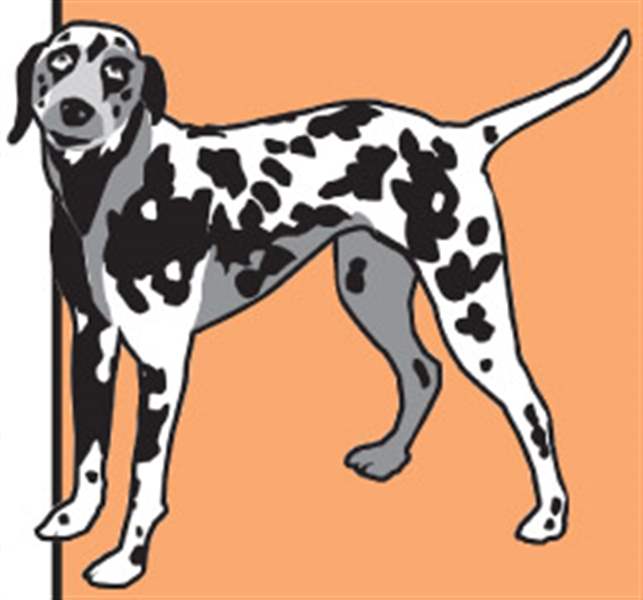
A language of their own: How to understand what your dog is trying to tell you
11/7/2009
• Tail at half-mast • Ears resting near head • Body not tense, legs not braced • Dog is engaging in direct eye contact and still relaxed • Neutral body orientation
Pretend for just a moment that your dog is not your little sweetie-kins, lovey-bear, but is instead an animal.
Suspend your reality long enough to accept she's not your cuddle-bunny that gazes adoringly at you because she loves you so much, but is actually a close descendant of a wolf.
She is not your baby.
She is a dog, a creature of nature.
And so, having accepted this reality, watch her closely when she's at the park and she eyes another dog up ahead. You tell her to sit and her eyes get wide, she licks her lips, and then, after glancing up at you, yawns.

• Intense expression • Ears up • Orientation of nose and eyes is the same n Tongue off to side
Guess what she's saying. Is she hungry? Near-sighted? Tired?
None of the above.
Actually, according to dog experts, what she's most likely communicating is, "See that dog up there? It's making me nervous and I'm not sure you can handle this situation, human. I'm licking my lips to sort of give me something else to think about — kind of like a nervous tic — and that yawn is the same deal. I'm not sure about this, so let's proceed with caution, lest I have to take command and give that beagle a piece of my mind."
To state the obvious: dogs can't talk. Nor are they even remotely human. Their world is one of intensely attuned elemental senses — smell, touch, sound, taste — and the only way they can communicate with you and other dogs is through their body language.
"It's everything," said Toledo area dog trainer Bill Marek. "You can tell how you can push the dog, what the dog is feeling, how the training is going. It's very important.
"There are certainly different personalities of dogs. You can tell if they're getting pushed to the limit or they're scared or if they're gaining confidence by their body language."

• Tail at half-mast • Ears resting near head • Body not tense, legs not braced • Dog is engaging in direct eye contact and still relaxed • Neutral body orientation
In her 2005 book Canine Body Language A Photographic Guide Interpreting the Native Language of the Domestic Dog (Dogwise Publishing, 372 pages, $39.95), Michigan dog trainer Brenda Aloff breaks down myriad gestures — many subtle, some obvious — that dogs do instinctively and intentionally to communicate.
Everything from the tilt of their head to the set of their eyes to how loose or tight their lips are can convey emotions from pleasure to intense anxiety, according to Aloff's work.
"Living with dogs means that you must work at finding a common language between the two of you," she writes in her introduction. "This is frustrating in the extreme for both species. While humans are constantly trying to talk to dogs as if they were people, simultaneously dogs are trying to talk to people as if they were dogs."
Which can lead to lots of confusion because we're not speaking the same language.
"What you think the dog likes and what the dog [actually] likes might be completely different things," said trainer Terry Hamlin of Gardner Dog Training in Sylvania.
He offered some basic tips to keep in mind when you're approaching a dog that doesn't know you. Obviously if the dog is standing there baring its teeth and barking, stay away. But even a submissive pooch can be a problem, so look out for a dog who's licking its lips, squinting, twisting around to make its body as small as possible, and exposing its genitals, he said.

• Puckered forehead • Ridges around eyes and lips • Eyes wide with dilated pupils • Ears and lips drawn back • Tongue out and flicking
This is a fearful dog that, especially if you bring your hand in from above, might just chomp on you to send a blunt message: get away.
"I'd say 80 percent of the bites come from fearfulness, without a doubt," Mr. Hamlin said.
Sylvania veterinarian Robert Esplin sees it all the time with dogs in his examination rooms. Naturally many of them are scared or anxious, so he approaches them with a combination of confidence and caution.
A vet since 1970, he focuses on their eyes — if they're dilated the dog "has adrenaline running through its system like no tomorrow" — and he proceeds with an indirect strategy.
"That means take it easy, go slow, this dog is unsure of the circumstances and needs to be handled kindly and gently," he said. "If you just try to grab them and wrestle with them and overpower them, that makes things worse."
By contrast, if a dog "exudes confidence" by making eye contact without staring, is happy to be approached, and is not licking his lips, then, Mr. Hamlin said, he's probably a friendly fellow.
Other signs of trouble are if the dog is "making itself big" by getting its hackles up, curling its tail up over its head, or allowing itself to "target" or stare at another dog or person. This is the equivalent of giving another dog the finger.
Never let your dog do this unless you want a fight and never play staring games with him yourself.
"Direct eye contact from one dog to another would be lobbing a grenade at you, firing a shot across your bow, and I see that even with puppies," Mr. Hamlin said.
"If your dog is targeting you need to get him to do something else instead. You would not want to pet something that was targeting you and staring."
The flip side of all this is our own body language and what we say to the dog. A confident person is going to naturally be accepted among dogs as a potential pack leader. And someone who gives consistent corrections, expects the dog to be obedient, and knows how to reward good behavior will earn a dog's respect and trust.
But it's not as easy as it sounds.
For example, Mr. Marek said, people regularly give their dogs mixed messages, especially owners of small breeds. Never pick your corgi or dachshund up and give him a hug or cuddle him when he's standing at the door barking, because all you're doing is telling him that kind of behavior will get him some love.
"Smaller dogs can be more aggressive than bigger dogs when we give them mixed messages because we actually praise them for their bad behavior," Mr. Marek said.
Mr. Marek said he sees it frequently at the park where a dog starts barking or acting up and the human bends down — this is bad body language because it says to the dog that you're not in control — and tries to soothe him, which, once again, rewards the animal for bad behavior.
The ultimate key to better understanding your dog is get him some basic obedience training (note that none of these guys are big fans of Cesar Milan, TV's "Dog Whisperer" for various reasons, including the fact that he generally doesn't include obedience training in his schtick) and pay attention to the messages you're sending him and that he's sending you.
"They need pack order. When [he's] doing something wrong it needs to be corrected, and when he's doing something good you should make sure you're praising the dog," Mr. Marek said.
And remember: They're not little people.
They're dogs.
Contact Rod Lockwood at: rlockwood@ theblade.com
or 419-724-6159